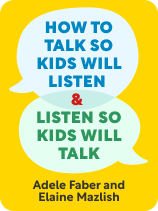

This article is an excerpt from the Shortform book guide to "How to Talk So Kids Will Listen & Listen So Kids Will Talk" by Adele Faber and Elaine Mazlish. Shortform has the world's best summaries and analyses of books you should be reading.
Like this article? Sign up for a free trial here.
Want to know how to encourage positive behavior? Why doesn’t punishment work when disciplining children?
To encourage positive behavior in children, educators Adele Faber and Elaine Mazlish claim it’s important to learn how to communicate effectively as an alternative to punishment. In How to Talk So Kids Will Listen & Listen So Kids Will Talk, they explain a few communication methods you can use to achieve this.
Read on to learn how to encourage positive behavior in children, according to Faber and Mazlish.
How to Encourage Positive Behavior in Kids
In How to Talk So Kids Will Listen & Listen So Kids Will Talk, Adele Faber and Elaine Mazlish’s final principle for communicating effectively with children is to use communication as an alternative to punishment. They explain that punishment is a distraction because instead of reflecting on their behavior and how they can do better, a punished child becomes angry and upset and wants to take revenge. But many parents are at a loss for what else to do. In this article, we’ll explain how to encourage positive behavior in children through communication, not punishment, according to Faber and Mazlish’s advice.
What Not to Do
First, Faber and Mazlish stress what not to do if a child misbehaves, no matter what age they are: Don’t do something unrelated to the offense like taking away a toy or sending them to their room. Punishment like this makes the child defiant and vengeful, and it doesn’t help them understand how they should behave differently in the future.
| Why Punishment Doesn’t Work In explaining how to encourage positive behavior without the use of punishments, Faber and Mazlish don’t explicitly define punishment, but they give examples of typical punishments: telling a child they can’t have a treat, excluding them from a family activity, or making them stand in the corner. Since How to Talk So Kids Will Listen & Listen So Kids Will Talk was published, there has been a wealth of research showing that these kinds of punishments—depriving a child of something they want, isolating them from the family—backfire. Dr. Laura Markham writes about some of this research in Peaceful Parent, Happy Kids: How to Stop Yelling and Start Connecting and in her articles for Psychology Today about how to encourage good behavior without punishment. According to Dr. Markham, punishment can make a child feel that they are bad, making them more likely to misbehave in the future. She adds that punishment fills the child’s brain with adrenaline, which renders them unable to reason calmly. Punishment also fails to bolster a child’s own developing morality; a child might behave out of fear of getting caught, but as soon as that threat is removed—when the parent is no longer watching—they’ll return to their old behavior. |
What to Do When a Child Misbehaves
Now, here’s how to encourage positive behavior, according to Faber and Mazlish: Focus on getting the right behavior in the future, not punishing the child for past misdeeds.
Ask Misbehaving Children for Their Help
Faber and Mazlish recommend redirecting children by enlisting them in a constructive activity. For example, if your children are grabbing toys at the store, ask them to help you shop for what you need.
Explain Why They Should Behave Differently
It may seem frustrating or repetitive to be continually explaining to a child why their behavior is problematic, but Faber and Mazlish recommend that you keep trying. Instead of criticizing the child, focus on the potential consequences of your child’s actions. For example, if your children are playing tag on the sidewalk and not looking where they are going, don’t label and punish them by saying, “You’re being so naughty—no treat for you today!” Instead, explain that people and dogs might trip over them.
(Shortform note: To encourage positive behavior, Sarah Ockwell-Smith recommends a mindful method she terms “Why? How? What?” Consider why your child is behaving that way, how they are feeling, and what your aim is in disciplining them. She stresses that the word “discipline” comes from the Latin for “to learn,” and thus it should not be about following rules but rather about teaching your child how to navigate difficult situations.)
Ask Them to Help You Solve the Problem
Another way to encourage positive behavior is to make your child part of the solution rather than making them feel like they’re the problem. This tactic echoes the earlier point about giving autonomy to get cooperation in return. Faber and Mazlish note that involving your child in brainstorming solutions (as previously recommended) can reassure them that you’re a team, and that you’re listening and taking their feelings into account. This approach isn’t about convincing your child that you know best, and they should do what you say. It’s about being open to solutions that your child suggests and trying to find a compromise.
Enlisting a child’s help in finding a solution draws on many of the skills Faber and Mazlish teach—giving reasons, giving choices, respecting your child’s feelings, encouraging autonomy, not giving your children negative labels.
Here’s how Faber and Mazlish say you should put the skills together to encourage positive behavior: Sit down calmly with your child.
- First, discuss their feelings and needs and then your own. For example, your child might want to keep playing with their friends, but you need them to be home before dinner.
- Brainstorm together about how to accomplish this, writing down any ideas, even if they are ones you can’t agree to—for example, even if your child suggests they be allowed to go out whenever they want, write it down.
- Then go back over the list, get rid of any unworkable ideas, and see if you can arrive at a compromise solution. You and your child may think of some creative solutions, and it won’t be about who wins the battle—it’ll be about how both of you can solve a problem.
| Discipline Should Fit a Child’s Developmental Level Ockwell-Smith notes when children engage in difficult behavior, they’re not being disruptive on purpose: They’re reacting to unrealistic expectations. Gentle Discipline is about readjusting parental expectations to take into account a child’s level of brain development. When How to Talk So Kids Will Listen & Listen So Kids Will Talk was written in 1980, we didn’t know that the last part of the brain to mature is the prefrontal cortex, which is involved in regulating emotion, making judgments, and controlling urges—and this maturation does not happen until a person’s late teens and early twenties. Children have a hard time with these tasks because their brains are not fully developed, and gentle discipline understands this and meets the child where they are. For example, children under four do not have a well-developed sense of how others feel, so it’s unrealistic to expect them to share. Encourage them, but don’t punish them for refusing. Gentle Discipline is full of ideas about how to readjust your expectations to fit a child’s stage and how to turn discipline into a learning experience. |

———End of Preview———
Like what you just read? Read the rest of the world's best book summary and analysis of Adele Faber and Elaine Mazlish's "How to Talk So Kids Will Listen & Listen So Kids Will Talk" at Shortform.
Here's what you'll find in our full How to Talk So Kids Will Listen & Listen So Kids Will Talk summary:
- How to build mutually respectful relationships with your children
- How to make your children feel heard and understood
- Methods for effectively praising and scolding your children






